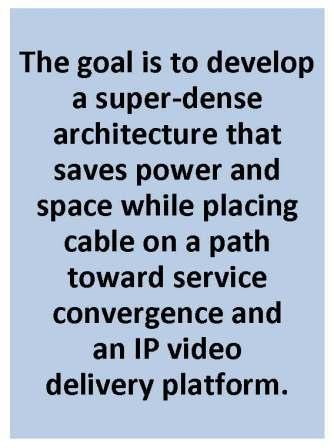
CHICAGO—Bid adieu to the dueling cable next-generation access networks from Comcast and Time Warner Cable. The two giant U.S. MSOs have decided to bury the hatchet and merge their two proposed industry standards into one.
At the Cable Show here earlier this week, CableLabs announced that it has settled the budding technical and operational differences between the two next-gen architectures – Comcast’s Converged Multiservice Access Platform (CMAP) and Time Warner Cable’s Converged Edge Services Access Router (CESAR). Called the Converged Cable Access Platform (CCAP), the new compromise standard will basically incorporate features from both networks.
CableLabs also released an updated technical report to establish the new set of consensus requirements for the freshly christened CCAP architecture. It describes the new CCAP device, which is designed to integrate the functions of the now-separate edge quadrature amplitude modulators (QAMs) and cable modem terminations systems (CMTSs). The goal is to develop a super-dense architecture that saves power and space while placing cable on a path toward service convergence and an IP video delivery platform.

This development should give heart to equipment vendors that they won’t have to spend significantly more capital developing two separate products for the two MSOs. Under the compromise, cable operators will retain the flexibility to set technical requirements that go beyond the CCAP specs. CableLabs is also developing additional specs that will address CCAP’s operational and support systems.
“This blending of our two approaches will help create an industry-wide approach for access technology platforms,” said Comcast Cable CTO Tony Werner. “We are engaged in this CableLabs process and are actively contributing to its efforts on CCAP.”
“We are pleased with the industry consensus for the next generation of access platform,” said Mike LaJoie, CTO of Time Warner Cable. “This platform will provide the economic scale for the industry to provide new high bandwidth services.”
What exactly does CCAP resolve? One material difference between CMAP and CESAR had been the preferred size of the new device. To settle the matter, the CCAP specs will define two sizes — one size for cable systems that serve many service groups and a smaller version for networks that handle smaller service groups. CESAR had called for smaller serving areas, while CMAP had profiled both big and small service groups.
In another important point of consensus, CCAP allows cable operators to either integrate their encryption systems or keep them separate. CMAP had called for integrating the encryption systems while CESAR had called for keeping them separate.
CCAP will still offer cable operators and vendors the option of developing integrated and modular versions. CMAP had endorsed both approaches, while CESAR had favored a more integrated implementation. CCAP will also feature a proposed migration path originally developed for CMAP, which will enable cable providers to deploy gear initially in downstream-only mode.
The consolidation of the two separate but equal standards has been in the making for a while. Other leading MSOs and tech vendors have been pressing Comcast and Time Warner Cable hard for months to settle their differences for the good of the cable industry.
Not surprisingly, then, Cox Communications, one of CMAP’s key contributors along with Rogers Communications, immediately blessed the CableLabs announcement. “The CCAP architecture will be an important element of our future strategy for access technology,” said Jay Rolls, senior vice president of technology at Cox. “It will be very helpful as we continue to assess our deployment scenarios.”
Field trials of these next-gen access network products were expected to start this year and then expand in 2012. Comcast executives, who will likely go first with tests and pilots, said their deployment plans should continue as scheduled.
Incidentally, CableLabs is no stranger to this issue. In January, Comcast, Cox, Rogers and their other partners transferred the interface specs for CMAP to the R&D organization, with the intent of developing a multi-vendor, interoperable product ecosystem.
Alan Breznick is a Toronto-based senior analyst at Heavy Reading, part of the Light Reading Communications Network at UBM TechWeb. He is covering the Cable Show this week for Cartt.ca.



